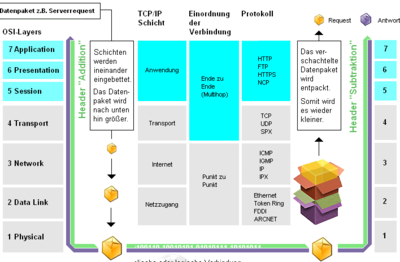Network Basics and Network Abstraction in Linux
Motivation
Before you learn the tools and commands for using the network in Linux you need a basic understanding of how networks work and this unit tries to bring you up to speed quickly.
The ISO-OSI 7 Layer Model
The 7 Layer Model is used to describe networks. The IP Protocol has not been developed within ISO and thus only roughly fits into the mode. Still it is a good picture to have in you mind when you think about networks.
On Top you have your applications. Like e.g. a Web-Browser. Below you need definitions on the details of how websites are encoded and transported via HTTP. And so on. And at the bottom we need specifications on how data is transmitted at the wire (or wireless): E.g. cable definitions, voltage levels, frequency, etc..
What we are looking at here is the Layer 2: That defines how data is encoded on a certain medium and in later units also layer3 (Routing - how packets are sent between networks).
Layer 2
From the abstraction in the operating system we basically have 2 different kind of physical medium:
- broadcast
- There is a local network where stations can send to each other and also there is a way to send to all stations on the network. Typically an ethernet network segment or a WiFi network.
- point-to-Point
- Two stations connected via a link and only those 2 stations can exchange data. Typically a dial-up connection, a network over a serial line or a virtual connection like a VPN tunnel.
